
Feature Articles
(I) Food Safety Street
 |
Little B: Doctor, Doctor, can you stop my stomach-ache please? Mother: I have all along paid attention to hygiene. Why did my son still come down with food poisoning? Doctor: Let me take you to the Food Safety Street . Five Food Safety Ambassadors will explain to you in detail. |
 |
Ambassador of Preparation - Purchase Safe Ingredients

Ambassador of Preparation: Little B, first, we should buy fresh and clean food from reliable shops. We should not buy the food if its "expiry" or "best before" date is over. Wash the ingredients with tap water before cooking. Raw food (e.g. fruits and vegetables) should be washed thoroughly before consumption.
Ambassador of Fire - Cook Food Thoroughly

Ambassador of Fire: Apart from washing, we should cook thoroughly the ingredients, especially meat, poultry, eggs and seafood. Food should be consumed in two hours after cooking. The leftover food should be reheated at 75 ℃ or above before consumption. After that, all food that is still leftover should be thrown away.
Ambassador of Temperature - Keep Food at Safe Temperature

Ambassador of Temperature: That's right! Little B, food to be served hot should be kept at 60 ℃ or above before serving. Do not leave the food at room temperature for more than two hours. Food to be served cold should be stored in the refrigerator at 4 ℃ or below. Frozen food should be defrosted in the refrigerator.
Ambassador of Food - Separate Raw Food from Ready-to-eat Food
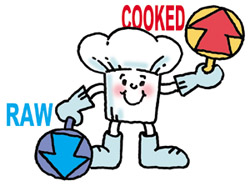
Ambassador of Food: We should cover the food properly before refrigerating. Ready-to-eat food (e.g. sushi) and cooked food should be kept in the upper compartment while raw food in the lower compartment to prevent cross-contamination. Also remember to use different knives and chopping boards for handling ready-to-eat food and raw food to avoid cross-contamination.
Ambassador of Hygiene - Keep Clean

Ambassador of Hygiene: Food hygiene is definitely important, but attention should also be paid to personal and environmental hygiene. Before handling food and after using the toilet, we should wash our hands thoroughly with soap or liquid cleaner. We should also wash our hands frequently when preparing food. If there are wounds on our hands, remember to cover them with water-proof plasters. Of course, we have to remember to wash thoroughly the utensils and worktops to keep the kitchen clean and prevent pest infestation.
(II) The Proposed Food Safety Bill
In view of the growing public concern over food safety, the Chief Executive announced in the 2007 Policy Address that he would introduce a Food Safety Bill to enhance the food regulatory system in Hong Kong and to strengthen the import control measures on some specified food types. The key features of the proposed Food Safety Bill are summarized in the ensuing paragraphs.
Definition of "Food"
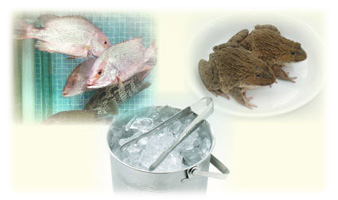
It is proposed that the definition of "food" under the new Food Safety Bill should be broadened to cover live fish, live amphibian as well as ice (which is commonly incorporated into food or drink). With this wider definition, the new food safety control measures proposed under the Food Safety Bill will be applicable to these food types.
Mandatory Registration Scheme for Food Importers and Distributors
Given that some 95% of the food in Hong Kong is imported from overseas, there is a need to establish a well-structured and comprehensive database of all food importers and distributors in Hong Kong to facilitate food tracing. The Government proposes to include in the Food Safety Bill a mandatory requirement for all food importers and distributors to register with the Food Safety Authority. Only registered food importers and distributors will be allowed to import food into Hong Kong and distribute food. Food distributors will not include mere transporters of food and food retailers. Moreover, the Food Safety Bill will also stipulate that food distributors and retailers can only patronize registered food importers/distributors.
Food Traceability – Record-keeping Requirement
To trace quickly where the problem food came from and where it has gone to in the event of a food incident, we need to further require food importers and distributors to keep records on the movement of food. This requirement will also apply to all food retailers. However, food retailers will only be required to keep records of the business from which it obtained its food, but not information on the final consumers to whom it sold the food.
Specific Import Control for Food Types
Management at source is a key success factor for ensuring food safety. As Hong Kong relies heavily on imported food, this basically means import control. In order to ensure that all food which enters Hong Kong is fit for human consumption, various import control measures for different food types will be implemented according to their risk level. There is also the need to balance the risk factor against the concerns of the public and the trade about over-regulation which will result in higher compliance cost, and hence higher food price and reduction in food choice.
To cater for food brought in by members of the public returning from overseas, it will be stipulated in the Food Safety Bill that import of certain food types by bona fide travellers for non-commercial use will be exempted from the import requirements.
Prohibition of Import and Sale of Problem Food and Mandatory Recall
Under the Food Safety Bill, the Food Safety Authority will be empowered to issue a prohibition of import order, prohibition of sale order and/or a recall order where the Authority has reasonable grounds to believe that the food concerned poses a serious health hazard to the public. This measure is solely for addressing public health concerns. Where the Food Safety Authority is aware that only the food products produced by a particular overseas plant or only the food products of a particular batch to be imported from overseas have problem, the prohibition of import order will apply to that particular plant or that particular batch of food, instead of the whole exporting country/place.
Consultation
Details of the proposed Food Safety Bill can be downloaded from the webpage of the Food and Health Bureau (http://www.fhb.gov.hk/en/press_and_publications/consultation/index.html). Should you have any views on the proposal, please send them to the Food and Health Bureau by mail, facsimile or e-mail on or before 31 March 2008 .
Food Branch, Food and Health Bureau
Government Secretariat
20/F., Murray Building
Garden Road
Hong Kong
Fax No. : 2136 3281
E-mail Address : food_safety_bill@fhb.gov.hk
Magnifying Glass

(III) Farm Inspection to Safeguard Veterinary Public Health
To let readers know more about farm inspection, our Reporter has interviewed Dr. TO Man-wai, Veterinary Officer, Food of Animal Origin Unit, Centre for Food Safety.
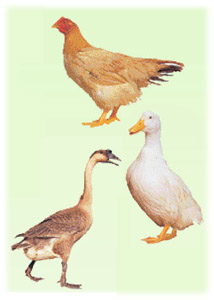
Reporter: Apart from local farm visits, do you have in place other inspections or control measures?
Dr. TO: The Veterinary Public Health Section (VPHS) conducts inspections throughout the year to registered Mainland farms supplying food animals to Hong Kong . Food animals include pigs, cattle, goats, poultry (including chickens, ducks and geese), freshwater fish and eels.
Reporter: What control measures are taken?
Dr. TO: With consumers' higher expectation for food safety, it is necessary to adopt a "feeds to table" integrated approach to control the supply of safe food. We visit Mainland farms to inspect their food animal species, mode of production, conditions of housing and breeding, veterinary drugs usage, any pesticide contaminants, animal health and care, etc. The aim is to ensure that food production is under proper control beginning from the farm.
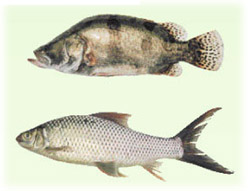
Reporter: Who will participate in the control work?
Dr. TO: Regulatory agencies, veterinarians and farm owners will take part in farm inspections. Farm owners are required to provide relevant information such as mode of vaccination, disease treatment, drug withholding period and husbandry management to help the veterinarians understand the farm conditions and animal health.
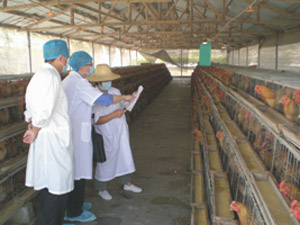
Reporter: So we need the assistance of the Mainland Authorities.
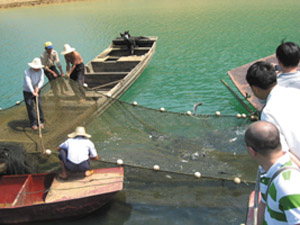
Dr. TO: Right. We always work closely with the State General Administration of Quality
Supervision, Inspection and Quarantine (AQSIQ) to ensure that the imported livestock and fish from the Mainland comply with our quality standard and statutory requirements. Last year, VPHS conducted 61 visits to registered farms with supplies to Hong Kong . Inspections have also been conducted to registered Mainland processing plants with chilled and frozen meat supplies to Hong Kong to ensure that the livestock still comply with our hygiene standard after being taken into slaughterhouses and processed.
Reporter: With such well-established control measures in place, food safety can be ensured.
(IV) Eating Globefish Can Result in Poisoning
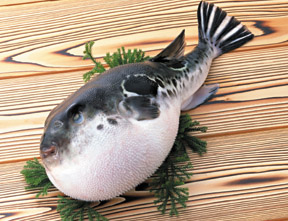
Every year, there are some food lovers suffering from food poisoning after taking the risk of eating globefish. Globe fish, commonly known as puffer fish, contains a potent and deadly toxin called tetrodotoxin. In globefish, the toxin is mainly found in the eggs, liver and skin. Unless the globefish is cleaned and prepared properly so that the organs containing toxins are carefully removed by special method, there are still chances that the flesh of the fish will be contaminated. The toxin cannot be destroyed by cooking, drying or freezing. The toxin can affect a person's central nervous system, and in extreme cases, can cause death. There is no antidote at present.
Other fish species, e.g. porcupine fish, may also cause tetrodotoxin poisoning. For more information about tetrodotoxin poisoning, please visit CFS's website ( http://www.cfs.gov.hk).
Advice to Consumers
Avoid purchasing and processing globefish, porcupine fish or unknown fish. The best way to prevent globefish poisoning is not to eat globefish.
Readers' Corner
(I) Sulphur Dioxide in Fresh Meat
Why is Sulphur Dioxide Added to Meat?
Consumers always make judgments of whether meat is fresh by its colour. Cuts of meat exposed to air for an extended period of time become brownish-red through natural oxidation. The meat will hence be regarded as not fresh and undesirable for consumption. Sulphur dioxide is illegally added to meat to quench the oxidative process so that the meat can retain its purplish-red or cherry-red colour for a long period of time.
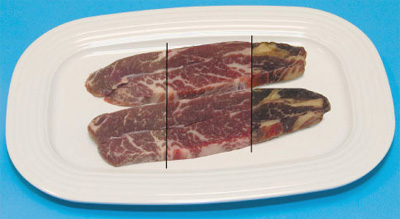
What is Sulphur Dioxide?
Sulphur dioxide is a preservative commonly used in a variety of foods including dried fruits, pickled vegetables and sausages. In addition to its anti-microbial and anti-browning functions, sulphur dioxide can delay discolouration in meat, fruits and vegetables caused by oxidation.
What are the Health Concerns Regarding Sulphur Dioxide Added to Meat?
Sulphur dioxide is a food additive of low toxicity. It is water-soluble and most of it tends to be removed through washing and cooking. Under normal circumstances, it should pose no adverse health effects on humans. However, for susceptible individuals who are hypersensitive to sulphur dioxide, there may be allergic symptoms including shortness of breath, headache and nausea.
Advice to the Public
- Purchase meat from reliable market stalls or fresh provision shops.
- Do not buy or consume meat which is unnaturally red.
- Since sulphur dioxide is of low toxicity and most of it can be removed through washing and cooking, adverse health effect is unlikely upon normal consumption.
(II) Nitrofuran Metabolites in Canned Luncheon Meat
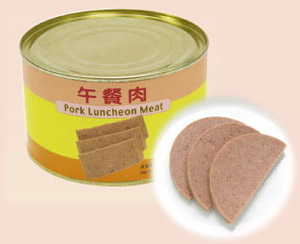
At the end of 2007, following the detection of trace amount of a nitrofuran metabolite in canned luncheon meat, the sole agents of the concerned products proactively initiated a recall and suspended sale of the affected canned food. The incident has raised much concern among the public. Nitrofuran is a chemical substance with general anti-microbial properties. It can be used in humans and animals. Nitrofuran, if used in pigs as a veterinary drug, will decompose into other substances or a nitrofuran metabolite with time and will remain in pigs as veterinary drug residues for some time. When the pork is used in the manufacture of canned luncheon meat, the meat may also contain veterinary drug residues.
Despite the presence of evidence showing that nitrofuran may cause cancer to animals, there is insufficient evidence proving that nitrofuran is carcinogenic to humans. The use of nitrofuran in animals has already prohibited in a number of countries (including EU member states, the US, Canada, Australia and Mainland China).
CFS has taken a total of 19 samples of canned pork products of the brands in question for testing. Among them, two samples are found to contain a nitrofuran metabolite. The levels detected are low, and normal consumption should not pose health risks to consumers.
(III) Heavy Metals in Dried Oysters
It was reported in December 2007 that the cadmium and chromium levels in two dried oyster samples from Lau Fau Shan exceeded the legal limits. This has aroused public concern. How are the cadmium and chromium levels in dried oysters determined?
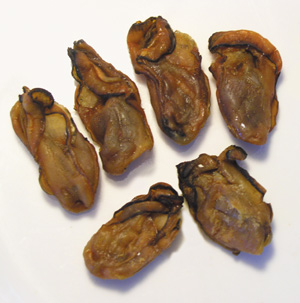
How are the Levels Determined?
Heavy metals and a number of environmental contaminants are ubiquitous in the nature. While their total amounts in food may not be changed upon processing, their levels may be either concentrated or diluted. CFS has therefore determined the "original" level of the contaminant in the processed food by using appropriate factors as recommended by the Codex Alimentarius Commission (Codex) in its General Standard for Contaminants and Toxins in Foods. This approach has been adopted by countries including Australia and EU member states.
By applying the "conversion factor", the reported cadmium and chromium levels in the two dried oyster samples are within the legal limits in Hong Kong.
Can the Above Approach Ensure the Supply of Safe Food in Hong Kong?
People often confuse the limits stipulated in law with the respective safety reference values such as the Provisional Tolerable Weekly Intake (PTWI) established by the Joint Food and Agriculture Organization (FAO) / World Health Organization (WHO) Expert Committee on Food Additives (JECFA). To monitor and maintain food standards, the law states the amounts of chemicals allowed in different foods. Consuming food products with chemicals exceeding the legal standards does not automatically imply that the consumer's health is at risk. CFS will take into account the levels of the chemicals present in the food and the average quantity of the food consumed when assessing the overall safety of the food samples and the associated health effects of the chemicals detected.
(IV) Introduction of the Nutrient Information Inquiry System
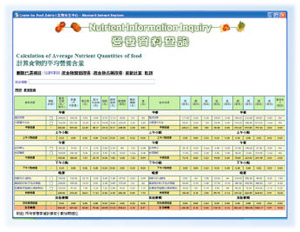
The Nutrient Information Inquiry System (NIIS) is a database available to the public for searching on the Internet nutrient data of food items which are of relevance and interest to them. Established in 2001, the system initially provided nutrient information on eight parameters of about 1 000 food items. The system was enhanced in May 2007. Now the database contains nutrient information on 18 parameters of more than 4 300 food items, including indigenous food items. The sources of data include the Food Research Laboratory of CFS and four overseas databases.

Moreover, a Food Nutrient Calculator was incorporated to the system in June 2007. The public can obtain the average nutrient quantity of food intake simply by selecting the food items and entering the consumption amount into the calculator.
NIIS was granted a Silver Award in the Best Public Service Application (Most Favoured) category of the 2007 Hong Kong Information and Communications Technology Awards. The website address of NIIS is http://www.cfs.gov.hk/tc_chi/nutrient/index.shtml.
Food News
Understanding Sodium
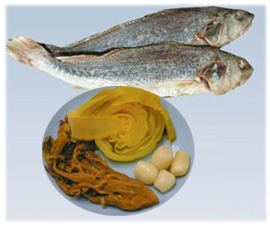
You may have heard of many campaigns promoting healthy diets. For example, in recent years there is a ‘3 less 1 more' diet, with salt as one of the ‘3 less' items. Salt is composed of sodium chloride. It is the main source of dietary intake of sodium. Sodium is a mineral and its major function is to regulate the fluid balance of the body. Sodium intake is closely related to blood pressure. Excessive sodium intake may increase the risk of high blood pressure, and hence the chance of coronary heart disease and stroke.
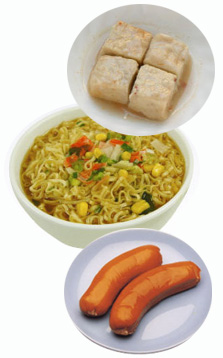
Q1: What is excessive sodium intake?
A1: The World Health Organization (WHO) recommends that daily sodium intake should not exceed 2 grams, or 5 grams when converted to table salt (equivalent to one flat teaspoon of salt).
Q2: Can excessive sodium intake be reduced by using less salt in cooking?
A2: It surely helps, but there is sodium in many seasonings (e.g. chicken flavour essence, monosodium glutamate, soy sauce and other sauces) as well as in preserved or processed foods (e.g. salted fish, preserved vegetables, fermented beancurd, instant noodles, sausages, luncheon meat). So we have to refrain from eating such high-sodium foods!
Q3: The food becomes tasteless when less salt and high-sodium seasonings are used. How to solve this problem?
A3: There are still many other natural seasonings available in the market. Food can be made tasty by making good use of the seasonings. For example, ginger, spring onion, garlic, pepper, chilli and far jiu bak kok (peppercorn and star anise) can make food taste better. Alternatively, broth made from chicken or pork bones can be used to enhance the flavour of food.
Food Safety Plan Corner
Critical Control Point of Preparing Scrambled Eggs with Shrimps
Scrambled eggs with shrimps is a homely dish. It is simple, tasteful and loved by people of all ages. When preparing this dish, attention should be paid to some critical points on safety. You may refer to the following safe cooking tips and prepare for your family a delicious and healthy dish. To cater for the ladies at work, frozen shrimps are used in this recipe.
| Ingredients (4 servings) | |
|---|---|
| Frozen shrimps................ | 225 g (about 6 taels) |
| Eggs................................ | 4 pieces |
| Oil.................................... | 2 tbs. |
| Seasoning | |
|---|---|
| Corn starch...................... | 1 tsp. |
| Pepper ............................ | a sprinkle |
| Light soy sauce................ | 1 tsp. |
| Salt ................................. | tsp. |
Steps
- Remove the intestines of thawed shrimps. Rinse, wipe dry and scald shrimps until cooked. Remove shrimps from water and drain.
- Beat eggs in a clean container, add seasoning and mix well.
- Preheat the wok and add 2 tbs. oil. Add egg mixture and fry slowly. Then add shrimps and stir fry until egg mixture fully solidifies.
Production Process
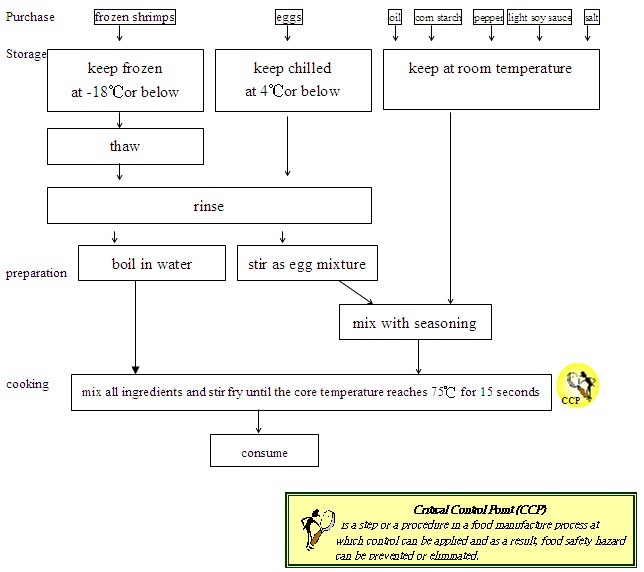
Safety Tips on Production of Scrambled Eggs with Shrimps
- Purchase
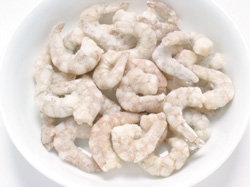
- Purchase ingredients from licensed and hygienic retailers.
- When buying the ingredients, make sure that
- there are no cracks and no dirt on the egg shells;
- frozen shrimps are stored in the freezer at -18℃ or below;
- all ingredients are used before the expiry date.
- Storage
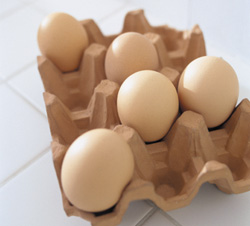
- Store the ingredients immediately at proper temperature
- refrigerate the eggs at 4℃ or below;
- store the frozen shrimps in the freezer at -18℃ or below.
- Practise the first-in-first-out stock rotation method.
- Store the ingredients immediately at proper temperature
- Thaw
- Thaw the frozen shrimps correctly, including
- store the food in the fridge at 4℃ or below; or
- put the food in the cool and running tap water; or
- use the microwave oven.
- Thaw the frozen shrimps correctly, including
- Preparation
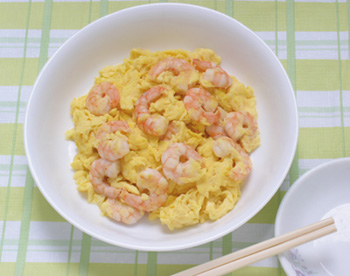
- Before cooking, rinse the ingredients and all food contact surfaces (including worktops, chopping boards and utensils).
- Before cooking and between handling raw food and cooked food, wash hands thoroughly with warm water and soap.
- Use two different sets of utensils (including knives, chopping boards, bowls and plates) for handling raw food and cooked food.
- Cooking
- Eggs should be fully cooked until egg yolk and egg white become solid.
- Shrimps should be cooked until they are not transparent.
 The overall core temperature of food should reach 75℃ for 30 seconds.
The overall core temperature of food should reach 75℃ for 30 seconds.
- Consumption
- The cooked food should be consumed as soon as possible. It should not be kept at room temperature for more than two hours.
Briefing of activities
(I) Consumer Liaison Group (CLG)
Established by the Centre for Food Safety (CFS) in August 2006, CLG provides a platform for the government to communicate and exchange views with the public on food safety issues. During the year, various activities were held for CLG members. Among them, there were 7 focus group meetings, which covered topics such as Egg Controls in Hong Kong, Proper Handling of Vegetables and Fruits, Development of Food Standards, Trans Fats in Foods, Effectiveness of Message Dissemination through CFS Website and Publications, and Proposed Regulatory Framework for Pesticide Residues in Food.
From CLG members' suggestions and comments provided in the focus group meetings, CFS understands the public's knowledge and risk perception of food safety issues. Appropriate publicity is planned so as to keep the public better informed of the food safety information released by CFS.
CLG members were invited to attend the Public Consultation Forums on Amendment to the Preservatives in Food Regulations and Proposed Regulatory Framework for Pesticide Residues in Food in Hong Kong held in January and December 2007 respectively.
CLG members were also invited to attend a talk on risk perception of food safety issues held in March 2007.
To express appreciation to CLG members for taking part in various activities over the year and promote continued participation, CFS invited some members to attend the Food Safety Day, a major event organized in August 2007, as invited guests. It is hoped that, after gaining personal experience in the diversified publicity activities, members will put forward more suggestions on similar activities in future.
In 2008, CFS will continue to work closely with CLG, promote communication with the public on food safety issues and enhance the food safety standards in Hong Kong.
(II) Public Consultation on the "Proposed Regulatory Framework for Pesticide Residues in Food in Hong Kong"
To better protect public health, facilitate effective regulatory control and promote harmonization between local and international standards, CFS proposes to introduce a new subsidiary legislation to govern pesticide residues in food. The proposed regulatory framework is set out in the Consultation Document on "Proposed Regulatory Framework for Pesticide Residues in Food in Hong Kong", which can be downloaded from CFS's website (http://www.cfs.gov.hk).
Public consultation on the above proposed regulatory framework began on 13 November 2007. Two public consultation forums were held in December 2007 to introduce and discuss the proposed regulatory framework. Majority of the participants supported the broad direction and principles proposed. They considered that the proposed regulatory framework could enhance food safety for further protection of public health.